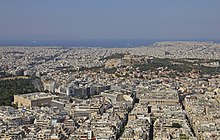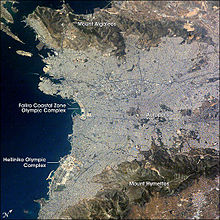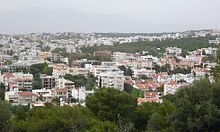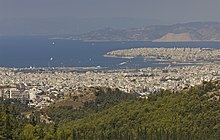Athens
This is the sighted version that was marked on June 17, 2021. There are 2 pending changes that still need to be sighted.
![]()
This article is about the Greek capital. For other meanings, see Athens (disambiguation).
f9f8
Athens - Modern Greek Αθήνα [aˈθina] (f. sg.), Katharevousa and Ancient Greek Ἀθῆναι Athênai (f. pl.) - is the capital of Greece. Athens is the country's most populous and largest city by area. The municipality of Athens in the centre of the metropolitan area of the same name is relatively small. This comprises the area of the regional districts of Athens-Central (88.1 km²), Athens-North (133.9 km²), Athens-South (70.2 km²), Athens-West (67.7 km²) and Piraeus (51.3 km²), with a combined population of almost 3.1 million (2011). The agglomeration, which is also relatively compact and whose core is formed by the municipality of Athens, has about 3.8 million inhabitants according to Eurostat, although other estimates assume at least 5 million inhabitants due to the lack of compulsory registration.
As the cultural, historical and economic centre of the country, Athens is also the most important metropolis in Greece. The airport is the most important in the country and the port of Piraeus, eight kilometres from the centre of Athens, is the largest in Greece. From here and from the smaller Rafina, the shipping traffic to the numerous Greek islands is also handled. In rail transport, Athens has national, but no international importance.
The city has been continuously inhabited since the Neolithic Age, making it one of the oldest settlements and cities in Europe. In 1985 Athens became the first European Capital of Culture. The Acropolis was added to the UNESCO World Heritage List in 1987 and the Daphni Monastery in 1990.
Athens was the site of the Attic polis in classical times. The Attic democracy that emerged during this period (5th century BC) is considered the founder of a political order based on the principle of popular sovereignty.

Athens agglomeration, in the background the Saronic Gulf

Athens seen from space
Geography
Location
Athens is situated in the widest plain of Attica, with the rivers Ilisos and Kifisos, and is surrounded on three sides by mountain ranges, the Hymettos (1026 m), the Pentelikon (1107 m), the Parnitha (1413 m) and Aegaleo (468 m), the fourth side opening onto the sea, the Saronic Gulf.
Climate
The urban climate of Athens is a very special one in Greece and also in Europe and was considered one of the best in the world before the city developed into the "water head" overgrowing almost the entire Attic basin and is still dry and largely mild today. The name Attica comes from file (Greek for "coast" or "promontory"), it is a peninsula.
Quite a few therefore moved to Athens or spent longer periods there, for example Sophie de Marbois-Lebrun, who had a villa built on the northern edge of the city and spent her twilight years there. In 1906, Rainer Maria Rilke wrote to Ernst Hardt, who lived in Athens, "to go to Athens for two or three months" to spend the winter there. Walther Judeich wrote in 1931 in his Topography of Athens
"The climate of Athens seems on the whole to have changed as little since ancient times as the picture of the landscape."
Josef von Ow wrote in 1854 that locals and strangers alike leave the city for a few days at the height of summer, and
"bring the hottest time in the mountains or on the islands to"
Due to Athens' location, surrounded by mountains to the west, north and east, and the prevailing winds in Greece, the climate in Athens is even drier and warmer than in other regions of the country. Summer temperatures can reach over 40 °C in the shade during hot spells, which can last three or four days and occur from June to September. Due to the dense population and lack of inner-city green spaces, it hardly cools down at night. Temperatures of 25 °C at midnight are the norm in summer, 30 °C not uncommon. Only towards morning does the thermometer briefly drop below 25 °C. In winter, on the other hand, there are more frequent cold air influxes from the north, which can then lead to snow cover at regular intervals, especially in the northern districts of the city. For Central European conditions, especially the November days are still surprisingly warm. While in other southern European cities it is already "winter temperatures", in Athens it is often still 20 to 25 °C during the day until the middle of November. On the other hand, spring starts later, and March and April are still surprisingly cool. The temperature averages in the cold season (December to February) are between 9.6 °C and 11.4 °C. There are also occasional frosty days with lows as low as -5 °C. In the warm season (May to September) the temperature averages range between 20.5 °C and 29 °C. Athens has over 2800 hours of sunshine per year and no less than 348 sunny days. On some days, sand and dust from the Sahara also blow to Athens and cover the streets.
Overall, the annual precipitation of 402 mm per year in Athens remains at a very low level. Most precipitation falls from the end of October to the beginning of February. The summer months of June to September prove to be particularly low in precipitation.
| Athens | ||||||||||||||||||||||||||||||||||||||||||||||||
| Climate diagram | ||||||||||||||||||||||||||||||||||||||||||||||||
| ||||||||||||||||||||||||||||||||||||||||||||||||
| Monthly average temperatures and precipitation for Athens
Source: meteoclub.gr; sunshine duration, humidity, water temperature: wetterkontor.de | ||||||||||||||||||||||||||||||||||||||||||||||||||||||||||||||||||||||||||||||||||||||||||||||||||||||||||||||||||||||||||||||||||||||||||||||||||||||||||||||||||||||||||||||||||||||||||||||||||||||||||||||||||||||||||||||||||||||||||||||||||||||||||||||||||||||||||||||||||||||||||
The industrialization and urbanization of the Attica peninsula, on which Athens is located, as well as increasing individual traffic since the 1950s, led to an ever-increasing pollution of the air, especially by smoke and sulfur dioxide. Smog (Greek το νέφος, to nefos, "the cloud") formed more and more frequently in the high-pressure weather conditions with a high risk of inversion (summer smog) typical of the region.
Although measures were taken as early as the 1970s to reduce air pollution, it increased in the 1970s and 1980s due to the rise of mass motorization resulting from the economic boom. The situation came to a head in 1987, when smog caused numerous deaths and the press reported increasing damage to ancient monuments. The authorities reacted with sometimes drastic measures. In order to reduce the volume of traffic, cars with even or odd numbers were banned from entering the city centre from 6:30 a.m. to 4:00 p.m. on weekdays, with narrow exceptions for doctors, journalists and tourists, for example.
Far-reaching measures by the authorities and the expansion of public transport have shown success and reduced air pollution since the 1990s. However, on very hot days, especially before the holiday season, air pollution is still an issue. The Greek Ministry of Environment publishes daily on its website the current air readings of Athens.
City breakdown
→ Main article: Athens districts and Athens suburbs
Old Athens of the 18th century roughly comprises the neighborhoods south and north of the Acropolis, the extension to the east and northeast (Syntagma to Omonia) has been the center of the city since the 19th century.
Although the inhabitants of the Attica peninsula consider themselves Athenians, the city of Athens is administratively limited to an area of less than one million inhabitants.

Athens North.
The Athens-Piraeus metropolitan area with its five regional districts and 40 municipalities. The municipality of Athens in white

Athens South and Piraeus in the background.
Founding myths and naming
According to legend, the goddess Athena and the sea god Poseidon courted the favor of the inhabitants of the then still nameless city. Both were supposed to give the inhabitants a gift each - whoever gave the city the most beautiful gift was to be chosen as the patron saint. The contest, which has been handed down many times, is found among others in Herodotus, in the library of Apollodor, in Pausanias and Plutarch. Poseidon gave the city a fountain or spring, which he opened with his trident, but from which only salt water gushed. In Ovid he gave the city a horse. Athena's gift was an olive tree. This gave food, olive oil and wood. Athena won and the city was named after her.
According to one tradition, Athens was founded by King Kekrops, which is why Kekropia (Κεκροπία) is an ancient name of Athens.
The name Athens was once always in the plural (Athēnai), but since the 1960s at the latest, the singular form has prevailed in Greek (Athína), officially the plural form is still found today. In most languages, Athens is still rendered in the plural.

Plato and Athena in the background, in front of the Academy of Athens.
Search within the encyclopedia


